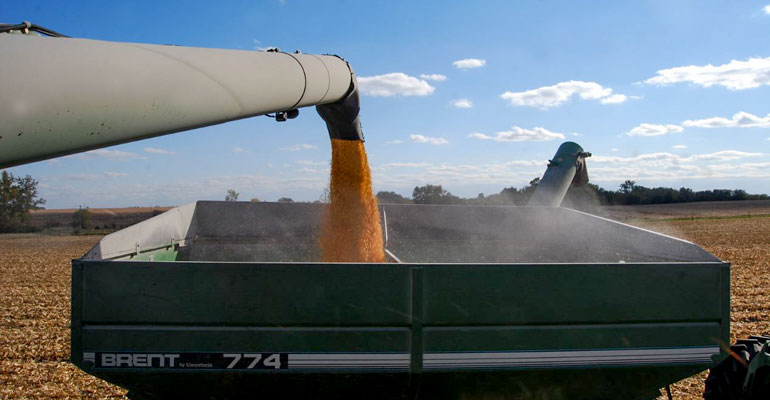August 29, 2019

As many farmers continue to struggle with high debt and uncertain markets, new attention is focused on remedies for financially distressed farmers. President Donald Trump on Aug. 23 signed into law the Family Farmer Relief Act of 2019. This law increases the amount of debt a farmer may have, yet still remain a “family farmer” eligible for Chapter 12 bankruptcy protection. The new law raises this threshold from $4,411,400 (indexed for inflation) to $10 million.
The industry will be watching to see what impact this change might have. Recent statistics from the U.S. bankruptcy courts show Chapter 12 bankruptcy filings increased from 475 between July 1, 2017, and June 30, 2018, to 535 between July 1, 2018, and June 30, 2019. In Iowa, this number increased from 18 to 24 during the same time frame. Although increasing, these numbers remain low. In 1987, nearly 5,000 farmers filed for Chapter 12 protection.
Why is new law needed?
Proponents of the new law argue that many family farmers who would benefit from the provisions of Chapter 12 have been unable to use Chapter 12 because their debt is too high. Farm size and corresponding debt loads have risen dramatically since 1986 when Chapter 12 was created. Despite inflationary adjustments every three years since 2005 (when Chapter 12 became a permanent part of the U.S. Bankruptcy Code), the debt limit has not kept up with the economic realities of modern farming. As such, some “family farmers” have been prevented from using Chapter 12 provisions that would allow them to avoid liquidation or foreclosure and continue farming in the wake of financial distress.
Chapter 11, the business reorganization chapter of the Bankruptcy Code, is not a viable option for many of these farmers. Court statistics do not identify when Chapter 7 (liquidation) or Chapter 11 (business reorganization) filings are farm-related. Thus, it’s difficult to know how many farmers have filed for bankruptcy protection outside of Chapter 12. The American Bankers Association had opposed the debt limit increase, arguing that the new limit could “ultimately increase the cost of borrowing for farmers and ranchers and reduce the overall availability of credit.”
Chapter 12 of the U.S. Bankruptcy Code was introduced during the 1980s farm crisis to allow farmers facing extraordinarily high interest rates on significant farm debt a chance to restructure their debt, make payments over time and remain in business. The law has undergone several major revisions since its creation. Chapter 12 is a reorganization provision designed for “family farmers and fishermen” with “regular annual income.” In addition to meeting the now $10 million debt limit requirement, individuals seeking relief as a “family farmer” under Chapter 12 must meet both of the following requirements:
At least 50% of the total debts that are fixed in amount (not including home debt) must be related to the farming operation.
More than 50% of the gross income of the individual or the husband and wife for the preceding tax year or for each of the second and third prior tax years must have come from the farming operation.
Establishing a repayment plan
Chapter 12 allows qualifying debtors to propose a plan that will fully pay all priority claims and repay secured creditors in an amount at least equal to the value of their collateral. The balance of the secured claim is treated as an unsecured claim. Chapter 12 debtors must commit any remaining disposable income to pay unsecured claims. Unsecured creditors must receive as much under the plan as they would if the debtor were to liquidate all non-exempt assets under a Chapter 7 bankruptcy. Chapter 7 generally marks the end of the farming business. Conversely, Chapter 12 can provide a fresh start for the business, if the farmer can create a “feasible plan.”
To establish a feasible plan, the debtor must demonstrate the ability to cash-flow the plan by making payments with regular, annual income. In light of current conditions, this is often a difficult requirement to meet. Chapter 12 can, however, provide eligible farmers an option to right-size their business and move forward with a leaner, more economically feasible operation.
This reorganization option is largely made possible by special tax provisions provided only to Chapter 12 filers. Chapter 11, the standard business bankruptcy reorganization chapter, doesn’t offer these protections. Chapter 11 is also more expensive, more time-consuming and otherwise more restrictive. Under Chapter 11, for example, debtors must pay unsecured claims in full, unless the creditors vote to accept a different treatment. This is known as the absolute priority rule, and it often prevents Chapter 11 filers from creating a confirmable plan.
Avoiding income tax liability
Under Chapter 12, tax debt associated with the sale of farming property is subject to priority stripping, meaning that these tax liabilities may be treated as unsecured debt and ultimately discharged. Without this special provision, tax liabilities would absorb substantial income otherwise available to create a feasible repayment plan. These farmers would have no option but to liquidate.
On Oct. 26, 2017, the Family Farmer Bankruptcy Clarification Act of 2017 extended this relief to farm assets sold after the filing of a bankruptcy petition. This law was in response to a 2012 U.S. Supreme Court opinion holding that taxes incurred due to the sale of farm assets used in the debtor’s farming operation could be treated as unsecured claims only if the sale occurred in the tax year prior to the filing of the bankruptcy petition. This meant that many farmers could not reorganize their operation by selling assets to “right-size” the business after the bankruptcy action began. And liquidating assets before the filing was often unworkable.
Even with these favorable provisions, Chapter 12 is not an option for many farmers facing financial distress. Farmers struggling to pay debt must consult with a legal expert in farm financial impairment sooner rather than later. Outside of Chapter 12, tax debt is generally not dischargeable. And liquidating assets to pay debt can create significant tax liability. This includes tax on the gain recognized from the sale of land (usually taxed at capital gains tax rates) and tax on the gain recognized from the sale of depreciated assets (taxed as ordinary income). The timing of a sale can significantly impact the amount of the tax owed.
Summing up: It remains to be seen if Chapter 12 filings will significantly increase, considering the increased Chapter 12 debt limit. In the meantime, farmers struggling with debt should consult with a legal expert to explore their options. We will continue to monitor this issue.
Tidgren is an attorney and director of the Center for Ag Law and Taxation at Iowa State University. Contact her at [email protected].
About the Author(s)
You May Also Like






